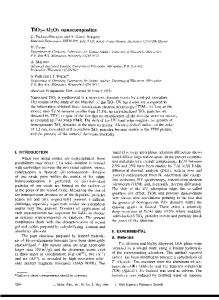Titanium preconditioning of Al 2 O 3 for liquid-state processing of Al-Al 2 O 3 composite materials
- PDF / 822,386 Bytes
- 11 Pages / 612 x 792 pts (letter) Page_size
- 65 Downloads / 341 Views
I.
INTRODUCTION
THE mechanical properties of alumina-reinforced aluminum matrix composite materials (especially high stiffness, high strength, high fatigue resistance, excellent wear resistance, low thermal expansion, and good creep resistance) make this material system very attractive for the automotive and aerospace industries. These composite materials are currently produced by techniques such as the Lanxide process (an in situ oxidation process), powder metallurgy, or ceramic-metal slurry casting. While aluminummatrix composites most commonly are powder processed, liquid-state processing of these materials is preferable with respect to cost-effectiveness.[1,2,3] Liquid-state production of alumina-reinforced aluminummatrix composite materials requires adequate interfacial bonding of the alumina-aluminum mating surfaces. A high bond energy interface between the metal and ceramic also is consistent with a change in the electronic structure of the atoms that comprise the interface. In the Al2O3-Al system, such a bond is thermodynamically feasible but kinetically difficult to achieve.[4] In experimentally obtainable atmospheres, aluminum forms nonwetting contact angles on alumina. Observed contact angles of 82 deg for sessile drop experiments in the temperature range of 660 7C to 1100 7C have been reported by Li.[5] Poor wettability of Al2O3 by aluminum and inadequate interfacial formation can be attributed to the following conditions: (a) low driving force for the reaction between liquid aluminum and aluminum oxide, and (b) presence of an oxide layer at experimentally obtainable oxygen partial pressures on the liquid aluminum, which is protective and acts as a barrier to intimate contact.[3,5–8] The wetting kinetics of ceramics in contact with liquid D.A. JAVERNICK, Research Associate, and G.R. EDWARDS, Professor and Director, are with the Center for Welding, Joining, and Coatings Research, Department of Metallurgical and Materials Engineering, Colorado School of Mines, Golden, CO 80401. P.R. CHIDAMBARAM, formerly Research Assistant Professor, Colorado School of Mines, is Member of Technical Staff, Semiconductor Process and Device Center, Texas Instruments, Dallas, TX 75243. Manuscript submitted October 24, 1996. METALLURGICAL AND MATERIALS TRANSACTIONS A
aluminum have been studied by others,[4,5,9–13] who found that the contact angle for many aluminum/ceramic systems was time dependent. Chidambaram et al.[4,9] reported an incubation time prior to wetting of ceramic materials by liquid aluminum at temperatures below 950 7C. The studies cited previously related the wetting of various ceramics by aluminum to the stability (both physical and thermodynamic) of the oxide layer present on liquid aluminum, and concluded that wetting was related to the destabilization of the oxide film via some dynamic process. Many researchers.[4–10] have reported substrate-independent contact angles of approximately 160 deg in sessile drop experiments performed under moderate vacuum, at temperatures from the melting point of aluminum
Data Loading...











